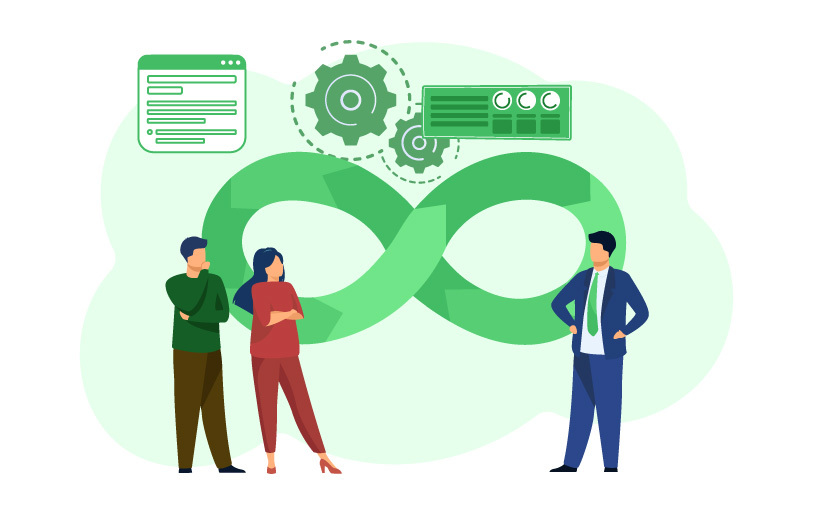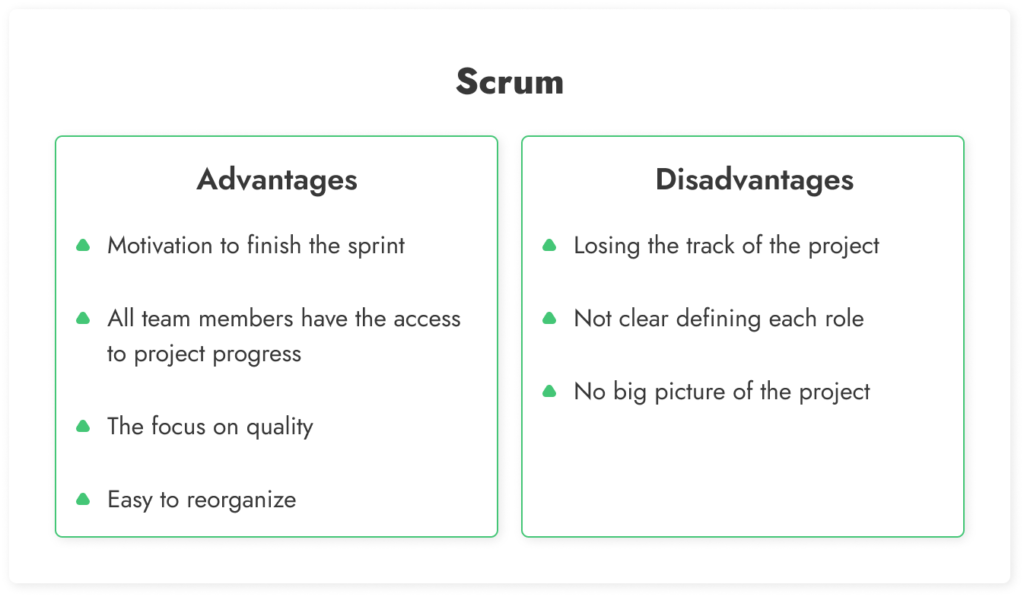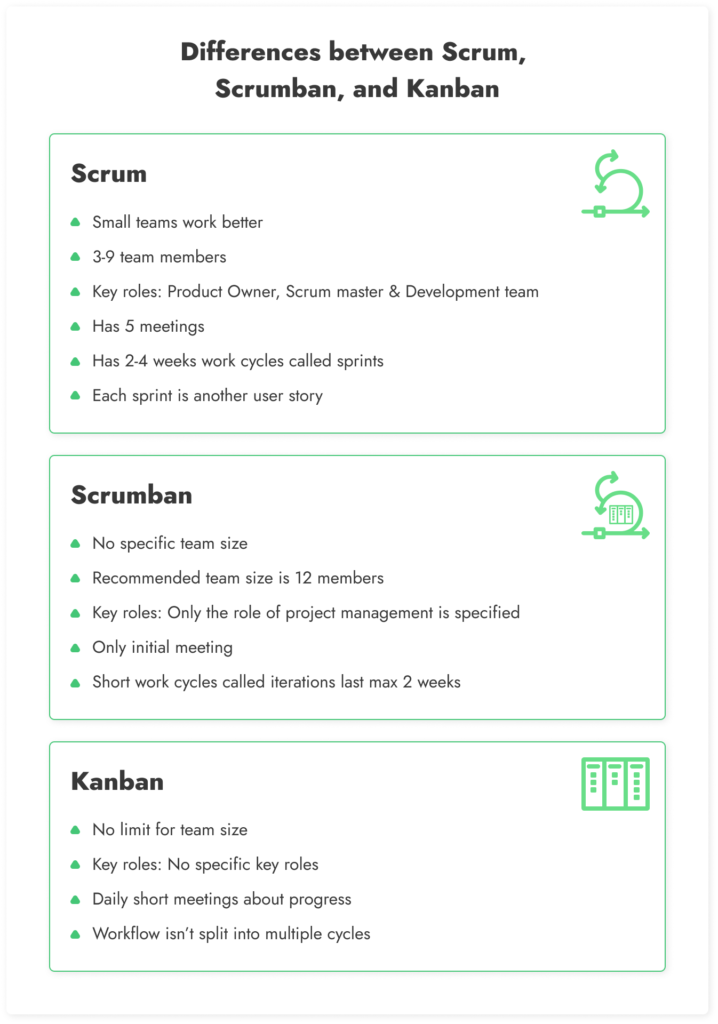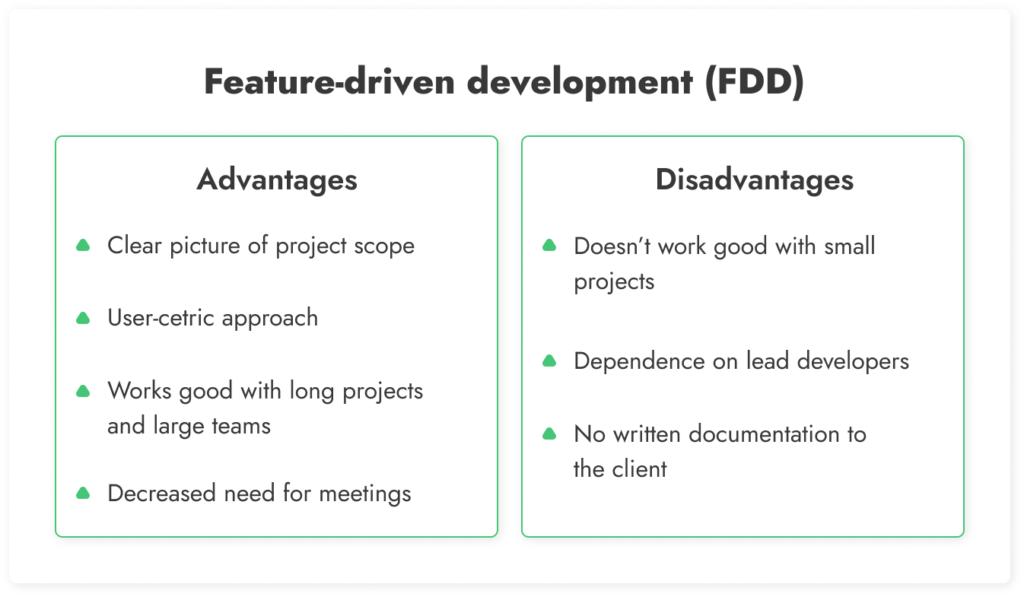Comparison of Different Agile Methodologies: Pros and Cons

Many sources compare waterfall and agile methodologies. However, that didn’t provide us an answer when we wanted to see the comparison of different agile methodologies.
Different agile methodologies are helpful to different teams. But, which one of them is useful for me?
In the article below we will discuss the most common agile methodologies and their weak sides. We are going to make a comparison of different agile methodologies and list their pros and cons.
What are agile methodologies?
Even though some say agile is dead in 2021, many software teams use agile methods. Through two decades of Agile history, many different agile methodologies emerged.
Let’s start with defining what they are.
Agile methodologies are a set of approaches to doing tasks that have the same goals. The goals are iterative development, orientation to customers, quick projects, and cross-functional teams.
Further, some of the agile methodologies that are used the most are Scrum, ScrumBan, Kanban, Extreme programming, and a combination of them.
Source: 15th State of Agile Report
Scrum
To start the comparison of different agile methodologies, we will explain agile scrum advantages and disadvantages. Scrum is a lightweight tool used primarily in software development. It breaks down projects into smaller tasks and assigns each task to date and a person in the team.
In other words, this Agile scrum methodology usually consists of a scrum board and columns in which are tasks about to be done. Tasks are then broken down into sprints. The team will work on each sprint at a time. Because of this characteristic, scrum visibly makes a great contrast to the “waterfall” model. On the contrary, the waterfall model emphasizes upfront planning of all the tasks.
Knowing how to work with scrum is an important project management skill. With this in mind, there are many opportunities for you to take scrum master certification online free test. We listed some agile scrum advantages and disadvantages in the photo below.

For the purpose of managing scrum successfully, there are many tools that provide scrum methodology. Some of them are:
Scrumban
The Agile methodology that is a mix of Scrum and Kanban results in Scrumban. Scrumban combines the structure of Scrum and the flexibility of Kanban. Further, it includes a pull-based system and a versatile approach. To put it differently, it results in great visualization.
Scrumban is a good choice for the ones who want to minimize the batching of work and have visual structure. In fact, it can be a transient from Scrum to Kanban. Certainly, that way shift between two methodologies will be easier. This mixture of two methods teaches how to improve Kanban skills without leaving Scrum structure.
To point out, there are some tools to use Scrumban:
1. Swift Kanban
2. Draft.io
3. ClickUp
Kanban
Kanban has the biggest growth of all different agile methodologies. Research by the SoK (State of Kanban) report shows that 41% of organizations applied Kanban across 10+ teams or the whole company.
It also shows that Kanban as agile methodology is used the most in software and internet services (20 %), consulting and professional services (18%), and financial services (15%).
Kanban is practical because its board splits tasks into three columns: “To Do,” “Doing,” and “Done.” The main characteristic is that you can easily see every part of the process flow. As the software develops, the information in the columns changes.
As shown above, transparency of this approach helps all team members to track at what stage the project is. However, spilling information between the columns often does the complete opposite. It makes it difficult to track.
With this in mind, there are tools that will help you to organize your project with Kanban:
Differences between Scrum, Scrumban, and Kanban
Although the difference between Scrum, Scrumban, and Kanban might be confusing, they do differ on some points. Some of the pointed differences are required key roles for managing the project. Also, they differ in team size that works the best for them together with a number of needed meetings.

Extreme Programming (XP)
The next commonly used Agile methodology is Extreme Programming (XP). Extreme programming is one more way of project management that practices continuous development. In brief, it has small releases in intervals or sprints, just like Scrum methodology. Thus, extreme programming is working with coding standards and collective code ownership.
The main goal in XP is customer satisfaction. Because of that, the XP method plans to test from the first day of development. The planning game and test-driven development make it more feature-orientated than previous agile methodologies. Since it easily manages changes in later phases of development, it enables continuous integration.
Some of the tools for extreme programming are:
- Targetprocess
- Plone Extreme Management Tool
- Maven and AntHill
- Ant and XDoclet
- AntHill and CruiseControl
Feature-driven development (FDD)
In Agile, feature-driven development is a methodology oriented more to features than task management. In other words, FDD is customer-centric and has a purpose to deliver results often. It supports status reporting at all levels. That ensures an overview of progress and results.
FDD focuses more on documentation and that is the reason why it needs fewer meetings. In fact, the communication about tasks is going through written requirements. The diversity from other Agile methodologies is that the end-user is not the Product Owner like in Scrum.

Look in the future
After a comparison of different agile methodologies, you can notice that they have a lot of advantages. However, if you remember that nearly 60% of project teams are cross-functional teams, you can come across doubt if they will work efficiently. Most of them solve the problem or they help with issue tracking, task tracking, and managing specific units of work.
In other words, when it comes to cross-functional teams, many assignments, and resources, these methodologies don’t take away the confusion. They lack to provide insight into what is next and what is the bigger picture. With focusing on issue tracking and no certainty about the bigger picture, the scope can change without control.
Which agile methodologies to use?
The issue tracking approach is not sustainable in a long run. In the future of project management, we expect methodologies that include feature tracking instead of issue tracking.
Feature tracking is the process of updating the progress of features in every discipline involved. That means that feature tracking provides managing every member’s tasks inside of a common goal. While issue tracking leaves you behind the project, feature tracking puts you in front of it. It also enables cross-functional teams to work efficiently and deliver the feature.
Feature tracking is what JadeALM software can provide you. It is not just a bunch of methodologies offered together, but it is a very crucial methodology that you need and that is synchronized. That way, you can track your project much faster than in comprehensive tools with a lot of different agile methodologies.



